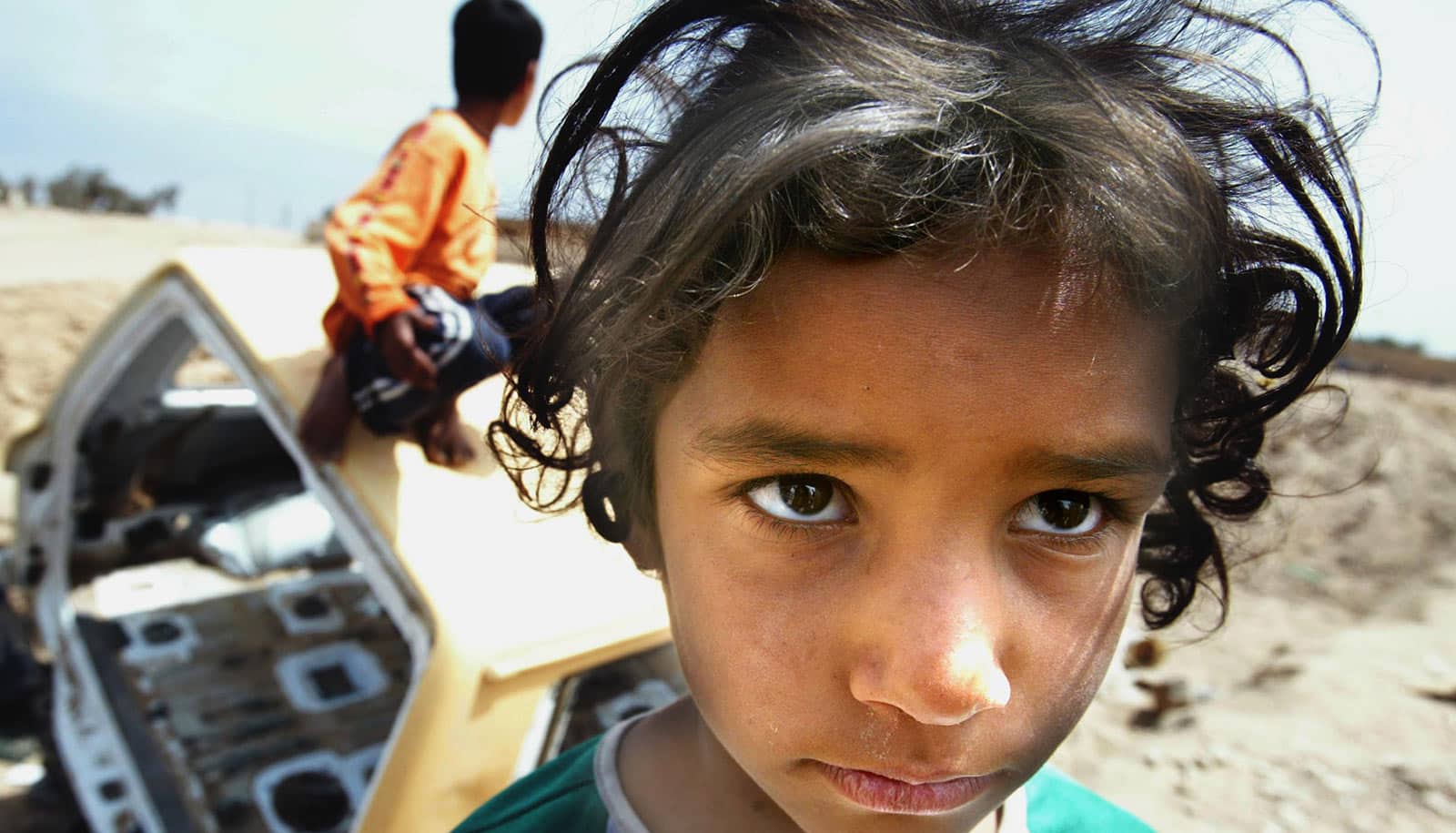
An Iraqi girl stands next to a bombed-out car where ammunition was found by British Royal Marines during a security patrol March 29, 2003 in Umm Qasar, Iraq. (Credit: Mario Tama/Getty Images )
Teen girls go unprotected in humanitarian settings
"Despite the fact that we know that violence against adolescent girls increases in humanitarian settings, this remains an under-researched and underfunded area of intervention."
Global efforts to end gender-based violence should strengthen their focus on adolescent girls in humanitarian settings, finds a new study.
A 10-year-old girl was living in a small village in southeastern Sierra Leone during the country’s decade-long civil war when the rebels arrived. “They said they were going to take the girls and boys,” she said. “I was the first person picked. They picked 20 girls and 20 boys. They took us to another town, and I was there one week. I was raped and couldn’t walk, so they left me there.”
“We have few evidence-based models for how to keep girls safe.”
This is just one of countless narratives of gender-based violence that adolescent girls face in humanitarian settings.
“Despite the fact that we know that violence against adolescent girls increases in humanitarian settings, this remains an under-researched and underfunded area of intervention,” says Lindsay Stark, associate professor at the Brown School at Washington University in St. Louis.
“Such focused attention is essential to meeting international commitments such as the Sustainable Development Goals.”
Stark is coauthor of the paper on the topic in The Lancet Child & Adolescent Health . The study presents a novel framework for gender-based violence risks facing adolescent girls in emergencies, synthesizes the limited evidence for relevant prevention and response, and identifies barriers to effective and ethical measurement and evaluation.
“We have few evidence-based models for how to keep girls safe,” Stark says. “This reality not only has relevance for many of the global settings in which I work, but also communities closer to home who are currently being hit hard by the COVID pandemic.”
Sexual violence against girls and women is common in humanitarian settings, mainly due to their combined vulnerabilities related to age, gender, and factors associated with conflict or disaster.
Among the limited studies that do exist, the majority come from sub-Saharan Africa and suggest that approximately 40% of female adolescents in emergency settings have experienced some form of intimate partner violence, Stark says.
In some humanitarian contexts, as many as 26.5% of adolescent girls have experienced nonpartner sexual violence, she says. Within the context of ongoing war, studies suggest that 29% to 44% of former female child soldiers experience rape during conflict.
Due to a lack of clear division of labor between gender-based violence and child protection sectors, adolescent girls are often neglected by both groups, and violence against this subpopulation too often goes unaddressed, the paper’s authors write.
The study included work in conflict-affected communities with refugees , both in camps and in urban settings ; internally displaced people; and communities affected by natural disasters.
“While some early evidence highlights promising interventions for transforming girls’ attitudes around violence and gender inequity and improving mental well-being, limited evidence supports the ability of existing approaches to reduce the incidence of violence,” Stark says.
“More explicit focus on adolescent girls is needed when designing and evaluating interventions to ensure global efforts to end gender-based violence are inclusive of this population.”
While many violence prevention programs focus exclusively on women or younger children, adolescent girls often fall through the cracks and lack the access and capital to advocate for their needs, she says.
Source: Washington University in St. Louis
The post Teen girls go unprotected in humanitarian settings appeared first on Futurity .
Share this article:
This article uses material from the Futurity article, and is licenced under a CC BY-SA 4.0 International License. Images, videos and audio are available under their respective licenses.
Related Articles:
Fighting more likely for teen boys who witness gender violence
Jan. 2, 2020 • futuritySexual partner violence against teens isn’t all the same
Jan. 3, 2019 • futurityLinks/images:
- https://www.futurity.org/teenage-boys-gender-attitudes-violence-2245542-2/
- https://doi.org/10.1016/S2352-4642(20)30245-5
- https://www.futurity.org/child-refugees-poverty-war-trauma-2198432/
- https://www.futurity.org/photojournalism-images-refugees-2075062-2/
- https://www.futurity.org/refugees-jobs-ethnic-communities-2119752-2/
- https://source.wustl.edu/2020/11/adolescent-girls-at-high-risk-of-violence-in-humanitarian-settings/
- https://www.futurity.org/gender-based-violence-humanitarian-settings-2479932-2/
- https://www.futurity.org


